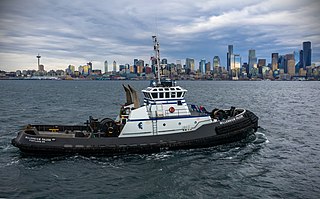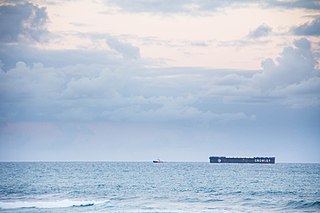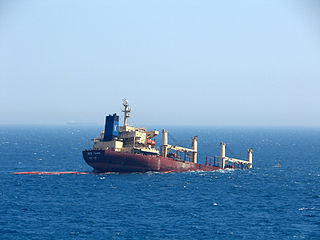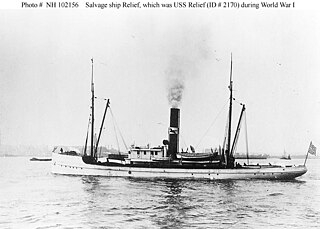
A tugboat or tug is a type of vessel that maneuvers other vessels by pushing or pulling them either by direct contact or by means of a tow line. Tugs typically move vessels that either are restricted in their ability to maneuver on their own, such as ships in a crowded harbor or a narrow canal, or those that cannot move by themselves, such as barges, disabled ships, log rafts, or oil platforms. Tugboats are powerful for their size and strongly built, and some are ocean-going. Some tugboats serve as icebreakers or salvage boats. Early tugboats had steam engines, but today most have diesel engines. Many tugboats have firefighting monitors, allowing them to assist in firefighting, especially in harbors.

Smit Internationale N.V. is a Dutch company operating in the maritime sector. The company was founded in 1842 by Fop Smit as a towage company with only the 140 horsepower paddle steamer tug Kinderdijk. Fop's sons, Jan and Leendert, continued the company under the name L.Smit &Co and expanded the fleet. In 1870, they began using tugs with propellers. After a merger in 1923 with Internationale Sleepdienst, the name was changed to "L. Smit & Co.'s Internationale Sleepdienst". Formerly listed at the NYSE Euronext stock exchange in Amsterdam, the company was fully acquired by Royal Boskalis Westminster in 2010.

The Grey Seas Under is a non-fiction book by Canadian author Farley Mowat about the Atlantic Salvage Tug Foundation Franklin, operated by the firm Foundation Maritime in Canada's Maritime provinces from 1930 to 1948.

A salvage tug, known also historically as a wrecking tug, is a specialized type of tugboat which is used to rescue ships which are in distress or in danger of sinking, or to salvage ships which have already sunk or run aground.

Crowley Maritime Corporation, is based in Jacksonville, Florida. Founded in 1892, Crowley is primarily a family- and employee-owned vessel management, owner, and supply chain logistics services company, providing services globally. As of July 2016, Crowley was ranked as the 13th largest private company in Florida, employing approximately 5,300 people worldwide with revenues of $2.2 billion. It provides its services using a fleet of more than 300 vessels, consisting of RO-RO vessels, LO-LO vessels, tankers, Articulated Tug-Barges (ATBs), tugs and barges. Crowley's land-based facilities and equipment include terminals, warehouses, tank farms, and specialized vehicles.

Empire Sandy is a tall ship providing chartered tours for the public from Toronto, Canada. She was built as an Englishman/ Larch Deep Sea-class tugboat for war service by the British government in 1943. After the end of World War II she was renamed Ashford and then Chris M before reverting to the original name of Empire Sandy and being converted to a schooner.

Alkimos was a Greek-owned merchant ship which was wrecked on the coast north of Perth, Western Australia in 1963. A nearby locality was later named after the vessel. The wreck is a popular diving venue.

SS Foundation Franklin was a seagoing salvage tug built for the Royal Navy as HMS Frisky in 1918. In 1924, the tugboat was sold and renamed Gustavo Ipland before being acquired in 1930 by Foundation Maritime and renamed Foundation Franklin. The tugboat became famous for many daring salvage operations and rescues between 1930–1949. Her many rescues and salvage triumphs were celebrated in Farley Mowat's book The Grey Seas Under. In 1948, the ship was damaged in a hurricane and not considered repairable. The tug was broken up for scrap in 1949 at Halifax, Nova Scotia.
USS Navajo (ATR-138/ATA-211) was an auxiliary ocean tug in the United States Navy.

MV Drake, previously known as Pasha Bulker, is a Panamax bulk carrier of 76,741 tonnes deadweight (DWT) operated by the Lauritzen Bulkers shipping company and owned by Japanese Disponent Owners. While waiting in the open ocean outside the harbour to load coal, Pasha Bulker ran aground during a major storm on 8 June 2007 on Nobbys Beach in Newcastle, New South Wales, Australia. It was refloated and moved to a safe location offshore on 2 July 2007 at 9:48 p.m. AEST before being towed to Japan for major repairs on 26 July 2007.

MV New Flame was a Panamanian bulk-carrier cargo ship. It collided with an oil tanker off Europa Point, the southernmost tip of Gibraltar on 12 August 2007, and ended up partially submerged in the Strait of Gibraltar. The vessel broke into two in December 2007 amid numerous unsuccessful recovery efforts. The cargo was salvaged and the stern section removed for scrap. Following the crew's rescue, the captain was arrested for having departed without authorisation. Charges of endangering shipping were later dropped.

Forceful is a sea-going tugboat built for the Queensland Tug Company by Alexander Stephen and Sons Ltd in Govan, Scotland in 1925. She worked at her homeport of Brisbane, Australia between 1926 and 1970 berthing ships and assisting nearby casualties. During World War II she was commissioned into the Royal Australian Navy in early 1942 as HMAS Forceful (W126), based at Fremantle and Darwin, until returning to commercial service in October 1943. She is preserved as a museum ship at Brisbane.

Luna is a historic tugboat normally berthed in Boston Harbor, Massachusetts. Luna was designed in 1930 by John G. Alden and built by M.M. Davis and Bethlehem Steel. She is listed on the National Register of Historic Places and is a U.S. National Historic Landmark. In 1985, the Luna was designated as a Boston Landmark by the Boston Landmarks Commission.

The fourth USS Relief (ID-2170) was a salvage tug that served in the United States Navy from 1918 to 1919.
Note: This ship should not be confused with the fourth USS Resolute (SP-3218) or fifth USS Resolute (SP-3003), which were in commission at the same time.

ST Cervia was built in 1946 as a seagoing tug for use as a fleet auxiliary by Alexandra Hall & Company Ltd of Aberdeen, Scotland. Today she is a floating Museum still undergoing restoration in Ramsgate, Kent.
USS WST-1 was a 325-ton salvage tug of the United States Navy during World War II.

Richard Holyoke was a seagoing steam tug boat built in 1877 in Seattle, Washington and which was in service on Puget Sound and other areas of the northwest Pacific coast until 1935. The vessel was considered to be one of the most powerful tugs of its time.
The RV MTA Sismik 1 is a decommissioned Turkish research vessel belonging to Istanbul Technical University. She is operated by its Faculty of Maritime for training purposes. Originally, she was owned by the General Directorate of Mineral Research and Exploration (MTA) in Ankara and operated by its division of Geophysical Directorate for subsea geophysical exploration.
HMAS Waree (W128) was a tug boat operated by the Royal Australian Navy (RAN) during World War II. She operated as a tug boat for the Waratah Tug and Salvage Company before being requisitioned by the RAN in 1942, and operating in northern Australia and Papua. She sank on 17 October 1946 off the New South Wales coast while sailing to Sydney from Thursday Island.